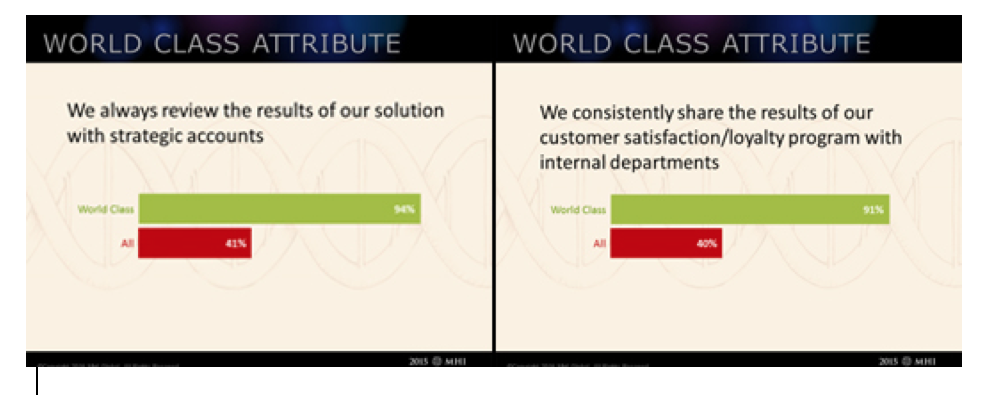We all know that in sales, obtaining new business is the Holy Grail. The question is what are you doing to protect and grow the customer that is feeding you today? Whether you call them key or strategic accounts, they are the accounts that are important to you
Are you building solid relationships that help your customers add value for their customers or are you just accepting orders and taking the business they provide you for granted? When was the last time that you sat down with your best customers and asked them to explain to you the reasons they are doing business with you and to describe the value you provide to them. Have you asked them to tell you if they are considering replacing you as a supplier? Furthermore, do you have a process in place to manage your key accounts and treat them as assets?
What the Research Says!
Results from the 2015 MHI Global Annual Sales Best Practices Research indicate the following:

The data is insightful to say the least. It indicates that world class organizations are building a brick wall around their key accounts.
In the first graphic, it shows that world class organizations do not take their customers for granted. Instead, they proactively ensure their customers receive value from their products and services by consistently demonstrating their value and asking their customers to acknowledge it.
In the second graphic, it shows that world class organizations are constantly looking for improvement in their customer intimacy efforts. They routinely conduct customer satisfaction and loyalty surveys and then they share the results internally. They proactively praise the good results and they take remedial action if it is required.
Warning Signs of Customer Defection
Here are some danger signals to warn you that an important customer may be considering a defection to an alternative provider:
- The customer says “we don’t need to meet as often”
- Your telephone calls don’t get returned as promptly
- Your customer reassigns you to someone lower in the organization
- New orders slow down
- Planned meetings are cancelled and not rescheduled
- Payments get extended
- You learn that they are talking to a competitor
- You hear that they doing a “trial” with a competitor
- They inform you that the next order must go out for RFP
- They purchase a quantity of a competitor’s product
Notice that in none of these situations did the customer tell you he or she was dissatisfied. When you see these signals, it should set off alarms, horns, bells and whistles. It’s a gift by the customer to inform you that the relationship is in jeopardy. Unfortunately, customers don’t owe you an advance warning. Sometimes, the relationship deteriorates over time as a result of poor product quality, late or incomplete deliveries, invoice discrepancies etc. Other times, it’s a competitor-driven action– a new product introduction or a not very favorable price comparison.
An Ounce of Prevention
- Prioritize: Not every account is a key account. Pick your key accounts carefully. Ensure they value you as much as you value them.
- Engage: Selling is a team sport. Develop a cross functional team from your organization that interfaces with their counterparts within the buyers organization. This improves relationships and identifies new areas of opportunity and improvement.
- Agree: Determine metrics for success. This defines specifically what the key customer wants from you.
- Measure: Don’t assume anything. Develop a comprehensive customer loyalty survey. Align multiple touch points between your organization and your customer’s company. Conduct the survey quarterly or bi-annually. Use the data internally to recognize success and highlight warning signs. Reinforce the key relationships and strengthen bonds.
- Grow: Don’t just think of the next order. Instead, think of the lifetime value of the customer.
- Refine: Always ask yourself two questions. First, where else could you be providing value to the customer? Second, if you were the competitor, what would you do to take this business away? Think beyond value provided. Find a “Wow” factor for your customer.
Questions to Ask Yourself Today!
Be objective and ask yourself the following questions. Then take the appropriate action.
- Are any of your key accounts in jeopardy for loss? What are the warning signs?
- Are you taking for granted your key accounts?
- What affect would it have on you today if one of your key accounts failed to renew a portion or all of their business?
- If we asked your best accounts to tell us exactly how they felt about doing business with you, what letter grade would you receive? Think A, B, C, D or F.
- What immediate steps must you take to protect the business you have fought so hard to earn?
Parting Thoughts
Remember your best customers are someone else’s targets. Relationships matter more than ever today and don’t let anyone tell you differently. Sure it’s a competitive world. Buyers have access to more information than ever and they have an array of choices. The one axiom that hasn’t changed in B-B sales is that people still buy from people. If you’re giving your key account the attention they deserve, then congratulate yourself. Upon reflection, if you find that customer relationships in your key accounts are strained or unresponsive, then take a step back and develop a plan to renew old partnerships.
As always we welcome your thoughts and input. Feel free to start a discussion.
If you would like a copy of the 2015 Executive Summary of the MHI Global Sales Best Practices Survey please send an E-Mail request to TWilliams@StrategicDynamicsFirm.com


